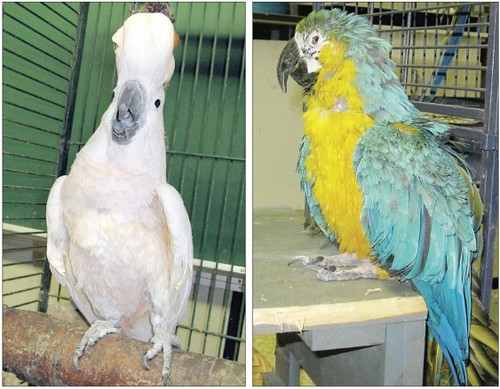 Two blind, elderly birds at the World Parrot Refuge in Coombs: Elvis, left, a Moluccan cockatoo, and Hello, a macaw that has been in Canada for 67 years. Photograph by: Wendy Huntbatch, World Parrot Refuge
Two blind, elderly birds at the World Parrot Refuge in Coombs: Elvis, left, a Moluccan cockatoo, and Hello, a macaw that has been in Canada for 67 years. Photograph by: Wendy Huntbatch, World Parrot Refuge
Residents relaxed on a leather couch, catching up on videos, at the new extended care centre in Coombs on Tuesday.
In a converted school portable, the World Parrot Refuge has opened a quieter, slower-paced home for geriatric parrots to live out their lives, away from the squawks and bustle of the main pens, which are in a separate building.
There are 14 residents so far and they seem to be settling in well, said Wendy Huntbatch, owner of the refuge, which houses more than 900 unwanted or mistreated parrots from across Canada.
The parrots have been have been seized because of poor living conditions, or turned in by people who can no longer care for them.
The ages of the geriatric parrots are unknown, but several of them have been in Canada for 40 to nearly 70 years.
“This afternoon, they were watching Free Willy,” Huntbatch said of the senior flock. There are also DVDs of David Attenborough’s The Life of Birds that are expected to be popular, she said.
“There’s a nice fireplace, so it’s like a home, and there’s a big leather couch, but that won’t last long when they start chewing it up.”
More geriatric parrots will be added soon, but Huntbatch is moving slowly to avoid shocking fragile birds.
“We have four blind birds in there now and there will be more,” she said. “It will also be for the special-needs birds. Some of them are pretty battered up when they come here.”
Blindness from vitamin A deficiency, caused by lack of sunlight, arthritis, congestive heart failure and epilepsy are among problems that afflict aging parrots.
There are also birds damaged by human behaviour.
“A lot come in with fatty liver disease. Instead of flying around all day, they have to sit there like a bump on a log and don’t get any exercise. All they get to do is eat,” Huntbatch said.
“One of the birds came from a drug house. It took three weeks for him to sit up and do things on his own.”
In the geriatric unit, cage doors are open and there is an occupational therapy area for painting and beak carvings.
Parrot paintings and cards are sold to raise money to run the facility; Huntbatch hopes carvings will be on sale this summer.
“They are very tasteful,” she said.
The cost so far for the addition is about $40,000, said Huntbatch, who relies on donations and grants to run the refuge.